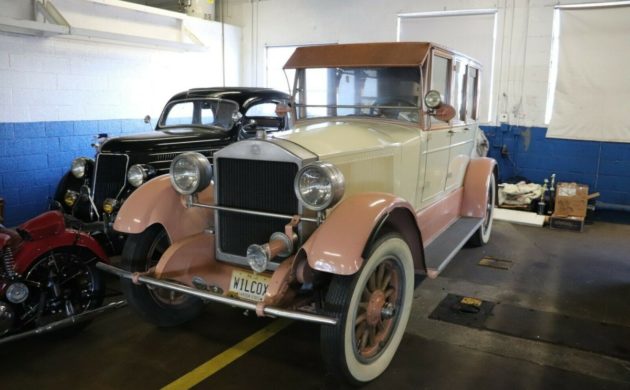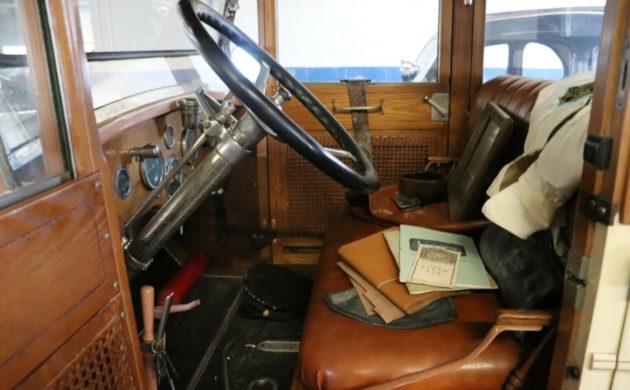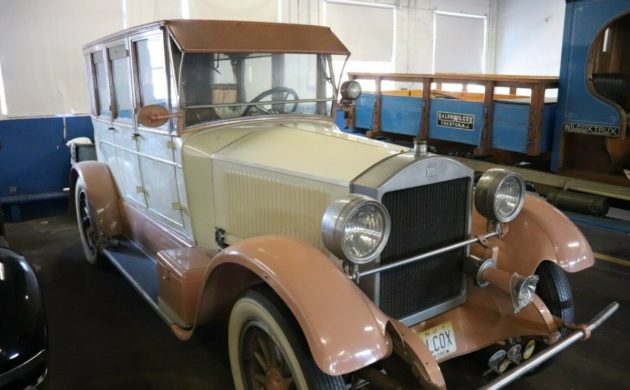If it wasn’t for visionaries willing to boldly tread new, interesting, and daring paths, we wouldn’t be able to enjoy the sorts of cars that we do today. Some of these paths have opened up for these individuals into vast freeways, while others have turned out to be blind alleys. The Stanley Steamer would fall into the latter category because while it represented some bold thinking that was well executed, it was also a car and a technology that found itself overtaken by rapid advances in internal combustion technology. This 1923 Stanley Steamer Limousine is a tidy example that is located in Lansdale, Pennsylvania. It has been listed for sale here on eBay, and while bidding has reached $16,000, the reserve hasn’t been met.
When you look at the outward appearance of the Stanley, there really is nothing that sets it apart from any other mainstream vehicle of the era. The body is quite conservatively styled, but a closer examination reveals the first indications that this vehicle is something quite special. Rather than utilizing steel for the body panels, Stanley chose to build the body of the Steamer from aluminum. This saved a significant amount of weight, which was vitally important in a car that actually produced fairly low power outputs. The body on this car looks nice and straight, with no obvious dings or dents. The vehicle underwent a restoration some years ago, but it has remained stored away in a barn for the last 10-years. The color combination of Beige and Peach is an interesting one when compared to other vehicles from the same era, and it is guaranteed to make the Stanley stand out in a crowd. The frame is said to be solid and rust-free, while the trim and chrome look like they would present well with a thorough clean and polish.
Lifting the hood of the Stanley reveals what makes this such a special car, and also why the aluminum body was more a matter of necessity than a luxury. What you see here isn’t an engine, but is actually a boiler that provides the steam power for the 2-cylinder engine, which is integral with the rear axle. On average, a Stanley carried around 16 gallons of water to maintain the steam required for the engine, and with that engine producing only around 20hp, you can see why there was a need to save weight with the body. Having said that, one of the great advantages of steam power is that while actual horsepower levels might be low, engine torque levels are extraordinarily high. With this in mind, the Stanley Steamer was never fitted with a transmission, because it simply didn’t need it. One of the characteristics that really sounded the death knell for the steam car was the amount of time required to get the vehicle up and running. While it took but a matter of moments to get the average internal combustion engine operating, with a Stanley Steamer, the process took around 20 minutes. This didn’t make it particularly convenient for just popping down to your local shop for a gallon of milk. It isn’t clear how long it has been since this vehicle was (literally) fired up, but given the impressive levels of steam pressure required to run the vehicle, I would be very inclined to have it thoroughly checked by a trained professional before I subjected the system to any form of steam exposure. One interesting fact about Stanley as a manufacturer is that one of their steam-powered vehicles actually held the outright Land Speed Record. It was set in January of 1906 at a very credible 127.66mph, and the record was not surpassed by an internal combustion vehicle until 1922. In fact, the Stanley actually managed to hold the steam-driven record right through until it was finally broken in 2009.
This Stanley is a Limousine, and when you consider just how expensive these vehicles were when new, it is easy to see why they were only bought by wealthy people who could also afford to employ the services of a chauffeur. When the most expensive Ford Model T cost less than $500 in 1923, a Stanley 740 set its owner back an eye-watering $3,900. The driver’s compartment of the Stanley looks neat and tidy, and apart from some mildew on some of the leather, it is in good condition. This was all refurbished as part of the original restoration, and all of the timber remains in nice condition. The leather upholstery on the seat is also in good condition, and this area of the car would seem to need little more than a good clean.
When compared to the driver’s compartment, life in the rear seat of the Stanley looks like it was very luxurious. Deeply buttoned cloth upholstery on the seats, an adjustable footrest on the floors, curtains on the windows, and even a pair of vases for freshly cut flowers really set the theme back here. Once again, all of the timberwork remains in nice condition, and as is the case with the driver’s compartment, a deep clean will once again have this area presenting at its luxurious best.
The development and refinement of the internal combustion engine, combined with their low production and sales cost, would eventually kill the concept behind the Stanley Steamer, and in 1923, the company was only able to produce and sell less than 500 cars. The writing was most definitely on the wall, and by the end of 1924, the Stanley factory closed its doors permanently. Today these vehicles remain a rare and interesting classic, and I really hope that someone buys this one and returns it to our roads. This is a car that is too interesting to leave sitting in a museum somewhere. It has served its time hidden away in a barn and really deserves to find its place back out on the open road.








Now here’s a car I can really get stoked up about! Makes me wonder about two
things–how many miles does it get per
gallon of water” and does Jay Leno know
about it yet?
Doble Steam Cars took the Stanley Steamer concept and improved on it considerably ! Dobles can be up and ready to go in a matter of a couple of minutes. They use a battery powered hot plate IN the boiler to create steam right away. Also Dobles captured the exhausting steam and sent it up the to radiator in front and condensed it back into water to be use again and again. Stanleys range was limited by the amount of water it needed. Dobles were/are also very fast. We has one in our local Horseless Carriage Club for a while. At a car meet the Doble was in an acceleration race with a Jaguar 150. The flag was dropped and the Jag took off fast, the Doble just sat there. The Jag was about halfway down the course when the Doble driver then took his foot OFF the brake that was holding back his steam motor, building up pressure and shaking all over like a scared puppy. It took off like a rifle shot and beat the Jag to the end of the course by several car lengths. That was close to 50 years ago. Just two years ago, I saw that very Doble again in a Concours, near San Francisco, still owned by the same family
Dobles were and still are the most advanced steam cars ever built. From a cold start to operating temp in less than five minutes. Once that’s over with, it starts and drives like a normal car…Dobles even had a primitive (but advanced for the time) analog computer to control the boiler. Stanley essentially encased the same drivetrain they had been making for over 20 years in this car with no real improvements (you still had to crawl under it to light the pilot). Jay Leno has 2 Doble cars and I suggest watching them, they’re fascinating automobiles.
Don’t see any chrome, look’s like nickel plating, which would be correct. Most makers didn’t start using chrome plating till about 1926 or so.
What a beautiful car. Driving a steam powered “anything” is an event. You start in the morning and finish in mid-afternoon. It is quite a process, from filling the water to blowing down the boiler at the end of the day. It is a leisurely process of sight, sound and smell that is not achieved by any other transport means. I love steam engines and would pay 16K for this in a heartbeat. But I suspect the selling reserve is many times that.
This is the condenser version of the Stanley so similar to a Doble in that respect. The Doble has a “flash” steam generator which heated much less water, hence the quicker time to running. Also, the Doble engine was much more powerful, so a steady 60mph was achievable vs 40mph for the Stanley.
I knew the man who restored this Steamer, Ralph Wilcox, from Lawrenceville NJ 08648. There is a video around of him talking about the restoration, the original owner and how to run and maintain this Steamer. I hope the video goes with new owners.
I have never seen a Doble,but I believe he came over to the UK and worked with Sentinel,who produced steam lorries until 1937 at their factory in Shrewsbury.They were later taken over by Rolls Royce,and the site is now a supermarket!
Does anybody know what this is worth? It is such a unique car. Being retired I can wait 20 minutes for it to warm up. I just have no idea what a fair market value would be.
Steam cars have a small but rabid following. This particular car is not all that attractive, so I would guess less than the same condition touring car. Also, because it is not running, it suffers from the same discount that other non running cars do. I’m going to guess market is 20-25k, but the estate is looking for 40-50k. So, just like any other car.
A little hard to wrap my head around the color scheme on this one, but it would be fun to drive.
Saw a Stanley on the road a few years ago up in Ohio, they FLY on the highway.
That said , I’d rather have the 36 Ford in the background.
Unlike a internal combustion engine, which has to have it’s RPM up to get torque, a steam engine produces its most torque at zero RPM! One thing about steam power, is that it can use all renewable fuel sources. Think wood and water. These links are of interest to steam enthusiasts. There are still several steam powered operations in existence today. If you search steam powered, you will get a lot of results: saw mills, cider mills, etc. There are a couple of good examples: http://www.sturgeonsmill.com/ , https://phillipsbrothersmill.com/
Stanleys actually use gasoline to run the pilots and heat the boiler…
I went to the ebay ad and watched the dealer video – Old Forge — they state right in the video “needs a good cleaning and detail” — isn’t that what anyone would expect a dealer selling an estate to do to make the car more attractive?
This is a museum piece car, maybe headed a few miles up the PA turnpike to Allentown’s America on Wheels or the Bulgari Collection
To me this is a very interesting subject. Steam powered cars. Now a inclosed and sealed recirculating freon powered steam engine using electric heating is feasible. It could be used either for direct drive power or to keep batteries charged in electric cars such as a Tesla. You’d have unlimited mileage without stops or recharging.
Back to the Stanley, beautiful car.
God bless America
If you want to get this to road worthy. Then gut out that steam crap and put in a gas or Diesel engine backed up by a 5 speed gear box. Nothing to fancy a 292 cid gm in-line six or a Buick straight 8. Maybe a cumins 4 cylinder. The reason it sat in the barn for 50 years is that these are a pain in the a$$ to operate and these boilers need to be recertified regularly. There nothing more than a rolling bomb. And when these boilers blow up it gets very messy. And usually someone dies. So either stick it in museum or stick in a gas engine. Third choice is put it back in the barn to rot away for another 50 years.
I assume you are 15 years old? You honestly have no idea what you are talking about. These NEVER blow up. Find me a news story where a Stanley or a Doble heat generator (IT IS NOT A BOILER) has blown up and hurt someone.
Ehh atleast he didnt say SBC…….Thats was what I expected .
Seems to be the answer for everything from a lawn mower to an air plane.
What I have always wondered ….and plan to investigate now this on my mind again ..Do you fire this with oil,chunk wood ,wood chips or whats best .
I think it was Jay Leno where I once saw a steam powered Ford T
Settle down guys I wouldn’t actually cut up this car. I was bored and wanted to see how many hate comments Id get. I’m disappointed I only got a few.
Look up Wikipedia for Pritchard Steam Car or Edward Pritchard (in Australia). In 1963 he added his steam engine to a Ford Falcon and had a government grant in 1975 for steam cars.
PeterfromOz again. If you read that article you will note that a lot of the funding obtained by Pritchard came from the US.
So tired of these brainless idiots making stupid comments…….
This is a very interesting read about Stanley Steamer Cars.
http://www.stanleymotorcarriage.com/GeneralTechnical/GeneralTechnical.htm
This car is so 19th century !
Yes so tired of stupid people who know nothing about it commenting..Go back to sleep.